|
Aermacchi C.200
I. serie Saeta “Bubble
Canopy”
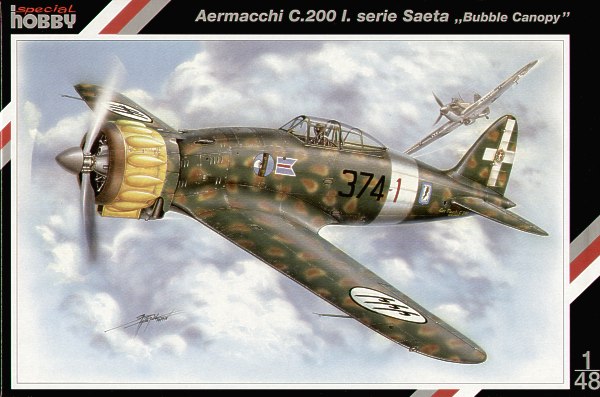
Special Hobby, 1/48
S
u m m a r y
|
| Catalogue Number: |
SH 48033 |
| Scale: |
1/48 |
| Contents and Media: |
41 parts in grey styrene, 2 parts in clear
vac-form for canopy, 45 parts in cream colored resin. Instructions and
decal sheet for three aircraft. |
| Price: |
USD$29.96
on line from Squadron.com |
| Review Type: |
FirstLook |
| Advantages: |
Nicely done
model of a minor Macchi variant. Very nice one-piece cowling. |
| Disadvantages: |
What is pictured on the box is not exactly what is
in the box. |
| Recommendation: |
Highly Recommended |
Reviewed by Steven "Modeldad" Eisenman

Special Hobby's 1/48 scale Macchi C.200 Serie I
is available online from Squadron
Special Hobby's 1/48 scale Macchi C.200 Serie I is
another welcome addition to the range of 1/48 scale WWII Italian single
engine fighters. Taking into account the out of production kits, there
is almost the complete range of front line, single engine fighters
serving with the Regia Aeronautica and the ANR available in 1/48 scale.
This new kit from Special Hobby (“SH”) is quite
interesting in three respects. First, SH must be given credit for
issuing a model of a Macchi 200 variant that was quickly replaced. The
most noticeable change that occurred was the elimination of the “bubble
top”. This was done for a number of reasons. The canopy was difficult
to open to allow quick escape, the quality of the clear material was
poor and visibility quickly degraded, and because of the lack of good
radios, Italian pilots used hand signals in close formation. A closed
canopy affected communication between aircraft.
Second, this kit is based on the Macchi 200 Serie
VII that was issued by Pacific Coast Models (“PCM”) not long ago. The
sprue with the wings, and nearly all the resin parts are the same as in
the PCM kit. The SH kit, however, does not have the etched metal that
was included in the PCM kit. The sprue for the fuselage, while having a
different fuselage and propeller, is basically the same as in the PCM
kit. Knowing that there was a great amount of research done in the
creation of the PCM kit, It would seem that, except for the new
fuselage, the same degree of research could be ascribed to the SH kit.
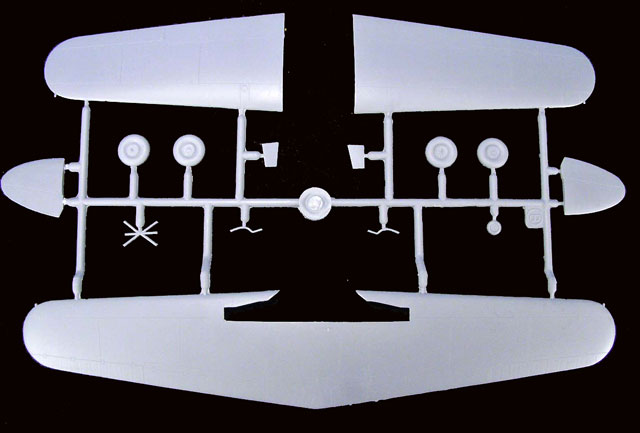
Click
the thumbnails below to view larger images:
Third, it is the new fuselage and propeller that
create issues with the color illustration on the box. The picture on
the box represents the earliest Serie I Macchi 200. This includes the
bullet shaped cover for the spinner hub (and Fiat-Hamilton propeller?),
the straight rudder hinge, machine gun barrels without blast tube
extensions and no rollover support structure under the canopy.
The parts in the box allow you to make a late Serie
I aircraft. The fuselage in the kit has the mass-balance offset hinge on
the rudder, no prop hub cover and it has the extended machine gun
barrels. But converting back to the early Serie I is not a big
problem.
To make the early version, simply fill the
horizontal part of the rudder line, and re-scribe, leave off the
rollover structure, and replace the machine gun barrels. You will need
to fine a bullet spinner for the prop hub. I still cannot figure out if
the prop would have to be changed, as it is quite unclear if the early
version had the Fiat-Hamilton prop or the Piaggio prop. One thing I do
notice is that the blades of the kit’s prop do not appear to be as broad
in chord, especially in the middle, as can be seen in pictures of the
specially designed Piaggio prop. The Piaggio prop seems to have a
significant bow shape to the trailing edge. The blades in the PCM kit,
which are cast in resin, appear to have a better shape (Note: the PCM
kit also has an injection molded prop, which seems to be incorrectly
shaped).
It should be noted that with regard to late Serie I
aircraft, there were even difference within this group. Since three
different companies produced the aircraft, one can find various
configurations. For example, there is a picture of a Macchi 200 with a
straight rudder hinge, but with the extended machine gun barrels and the
tail wheel placement of what looks like a Serie II, or later, aircraft.
Then there are aircraft with offset rudder hinge and the early style
tail wheel arrangement, as in the kit. But, in almost every case, if
the aircraft had a rollover support, it did not have a prop hub cover.
Regia Aeronautica enthusiasts will easily
understand the way things were done in the early years.
As to the kit parts themselves, they are “standard
limited run kit”. There is virtually no flash and the panel line
engraving is extremely fine, especially on the wings. Some modelers may
prefer to deepen some of the lines for a bit of emphasis.
The kit does provide for the engine support
structure, which is visible through the open wheel wells. As for the
engine, the actual support for attaching the cowling to the fuselage
will be the cylinder heads. There appears to be no positive attachment
point between the cowl and the fuselage. So careful fitting of the
cylinders to the crankcase will be important, so that the cowling will
fight tightly over them.
When Classic Airframes issued its Macchi 200 many
years ago, the cowling clearance bulges were in resin while the cowl
itself was two pieces of plastic. Each bulge had to be super-glued in
place. In the SH kit, as well as in the PCM kit, the cowling, the
clearance bulges and exhausts are all molded on a beautifully cast
single piece of resin. Of course, great care will be needed to separate
the cowl from its pour block.
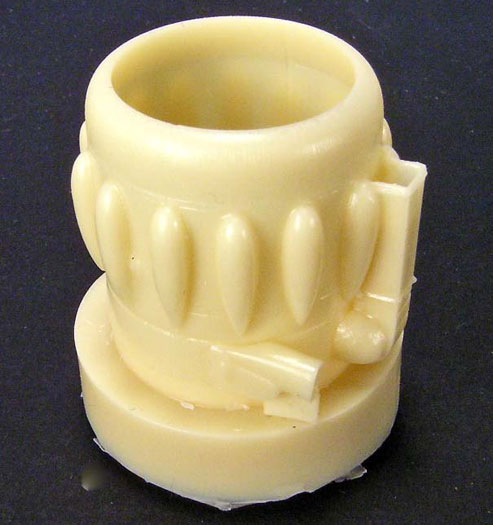
There are two substantial vac-formed canopies for
the bubble top. What I did notice is that the clear part seems to have
a blue tint.
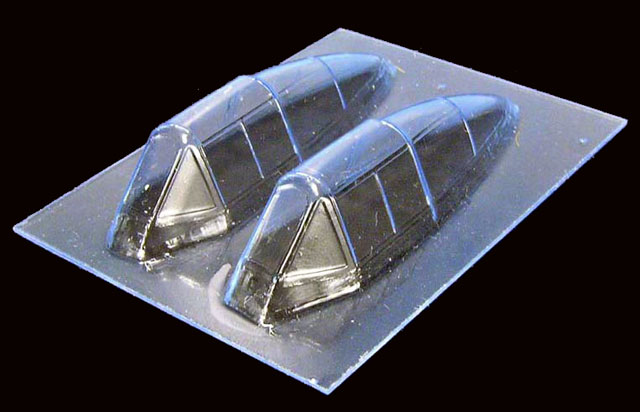
I’m not sure how this will appear on the finished
model. But it is noticeable.
Markings:
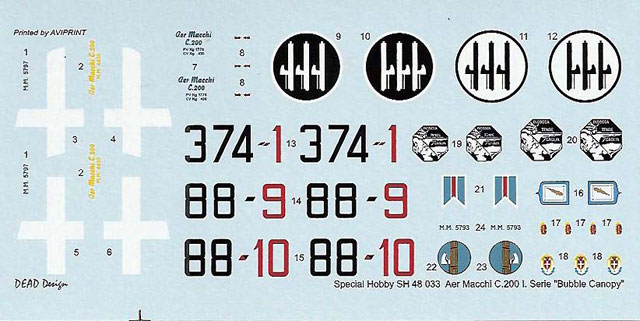
Click
the thumbnails below to view larger images:
-
374 Squdriglia, 153
Gruppo Autonomo C.T., flown by Mag. Andrea Favini, Gruppo Commander,
Grottaglie; April 1941. This aircraft is in a base color of Verde
2, with random blotches of Giallo 4 and Bruno Mimetico. The
underside is Grigio.
-
88 Squadriglia, 6
Gruppo Autonomo C.T., flown by M. G. Baschirotto. The aircraft is
in the “fried-egg” scheme of Verde 2 base with Giallo 4 blotches and
Bruno blotches on top the Giallo blotches. The underside is
Grigio.
-
88 Squadriglia, 6
Gruppo Autonomo C.T, Trapani-Milo; June 1940. This aicraft is in
the Verde 2 base color with random application of Giallo 4 and Bruno
Mimetico blotches. The underside is Grigio.
This model will be a very nice addition to any 1/48
collection of Regia Aeronautica aircraft, and I highly recommend it. If
you want to do it with the tri-color stripes on the fin and rudder, as I
plan to do, you will need to back date it to an early Serie I aircraft
and get the correct markings. The SKYmodels decal sheet 48-021, appears
to have marking for a few of the tri-color tailed, early Serie I.
Highly Recommended.
References:
Aer. Macchi
C.200; Ali D’Italia No. 8; 2000.
Macchi MC 200
Saetta pt. 2; Maurizio Di Terlizzi; IBN Editore; 2004.
The Macchi
MC.200, Profile Publications, No. 64.
Thanks to Special Hobby for the
review sample.
Special Hobby and MPM
kits are available worldwide through hobby retailers
worldwide
Review and Images Copyright © 2005 by
Steven Eisenman
Page Created 31 March, 2005
Last updated 31 March, 2005
Back to HyperScale Main Page
Back to Reviews Page
|
Home | What's
New | Features
| Gallery |
Reviews | Reference
| Forum
| Search